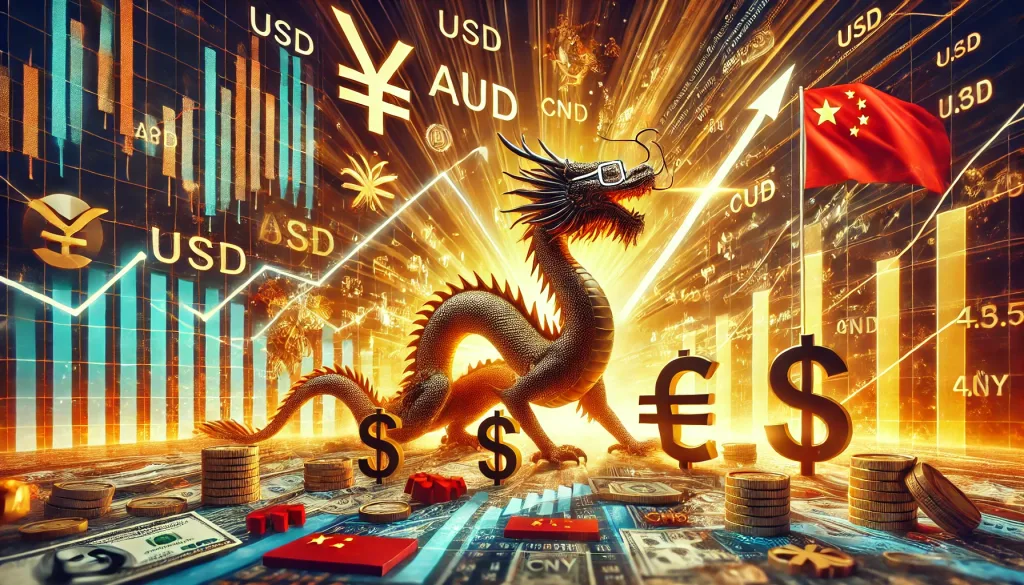Chinese Trade Magic: A Game-Changer for the Forex Market?

Chinese Trade Magic: A Game-Changer for the Forex Market?
Hold on to your pips, folks, because China’s trade numbers have blown past expectations—and not by a smidgen! We’re talking about a record-breaking Trade Balance of $95.72 billion for October. Let me put that in perspective: economists had predicted $76.03 billion, which makes this actual figure not just impressive, but a show-stopper, like discovering your boring friend is secretly a ninja. The surprise? China’s exports surged by a dazzling 12.7% year-on-year. Sure, expectations hovered around 5.2%, but this spike has redefined the game. What’s the secret sauce here, and more importantly, how can you, my savvy reader, squeeze some juice out of this financial lemon?
The Dragon Speaks: What This Means for the Market
There’s no doubt that China’s massive trade surplus is bound to influence the FX market—heck, it’s already creating ripples! But if you’re wondering how to navigate these choppy waters, listen up. The appreciation in Chinese exports means their products are moving faster than a trader looking at a collapsing trendline. This surge is a great signal for currencies tied closely to China’s economy, such as the Australian Dollar (AUD) and even the New Zealand Dollar (NZD). Forex traders need to watch out for these influences and might consider some unorthodox hedging to catch any tailwind from this event. Imagine the Chinese yuan sending a love letter to Aussie dollars—and yes, we’re talking financial romance here, not your regular K-drama plot.
Insider Scoop: “Imported” Trouble
But hold up. Imports didn’t look so hot this time, with a drop of 2.3% compared to expectations of a lighter decline at 1.5%. While exports are basking in glory, imports have decided to take a nap under the shade of the Great Wall. If you thought this was a problem only for China, think again—it’s a sneaky peek into how the internal demand is behaving. We often get seduced by export numbers, but imports reveal a different, often less glamorous, tale. This discrepancy suggests internal consumption is cooling, which could lead to slower growth down the line. In FX terms, it means staying cautious with currencies directly influenced by China’s demand, including commodities-backed currencies.
The “Yin and Yang” of Australia’s Balance
Speaking of commodities and kangaroos—the Australian Balance on Goods was a mixed bag of down under surprises. The trade surplus came in at 4.609 billion USD in September, a miss compared to the expected 5.3 billion USD. And here we see our Australian friends wrangling a -4.3% export change in goods and services. Meanwhile, imports slid by 3.1%. Picture the Aussie economy as an eager contestant on a game show, but every time it pushes a button for the right answer, it gets a mild electric shock instead. This drop in exports can heavily impact the Aussie dollar—it’s like taking out the strong center from a Rugby team, and the rest are trying to keep up with the play.
But here’s where the “yin and yang” come into play. Lower exports might drive a bit of a struggle, but look at imports—they are down too, which means that even though international demand may have weakened, local demand hasn’t exactly picked up the slack either. Traders should take note of the correlation to commodity prices here. With Australia being one of the largest exporters of iron ore, traders could see this trend impacting markets like Brazil and, oh yes, even currencies like the Brazilian Real.
The Silent Influence of Japanese Labor Cash Earnings
Not to be outdone by its regional friends, Japan chimed in with labor cash earnings data for September, clocking in at 2.8%. This number fell short of the expected 3%, but also—in a very Zen fashion—matched the previous month after revision. Here’s the thing: labor cash earnings aren’t the sexiest economic indicator, but they do matter for one major reason—consumer spending. A boost in earnings often triggers increased spending, which can nudge inflation upward, and that’s something the Bank of Japan loves (and secretly fears). The Yen’s reaction here might be subtle, but if traders know how to read the tea leaves—or in this case, sushi wraps—this data gives you clues about future Yen behavior.
Where the Real Magic Happens: Ninja Tactics for Savvy Traders
Alright, now that the basics are out of the way, let’s delve into the juicy insider tips that only the shrewdest of Forex ninjas know about. Consider the relationship between China and the AUD and the whispers of the market. While many traders follow the flow of the mainstream, there’s something to be said for shadowing the “real” market movers—the folks who look at trade balances not just as numbers, but as critical signals for long-term trends.
“The Silent Ripple Effect”: Spotting Hidden Opportunities
Trade balances aren’t just about the now; they’re an undercurrent—an invisible force that nudges the ship we call the global economy. Advanced traders know to watch what happens when a country’s exports outperform and imports fall behind. This balance can often result in an appreciating currency. By positioning yourself ahead of the news, you could stand to capitalize. Want a little-known secret? Using options to hedge your bets during these trade balance announcements is a strategy that the insiders use when they’re not too busy sunbathing in the Seychelles.
The Hidden Formula Only Experts Use
One strategy that isn’t openly discussed at trading seminars is the concept of “delayed pairing.” Think of this like the classic tortoise versus hare tale. Instead of rushing into trades based on immediate data releases, elite traders wait to see how the broader market digests the news—sometimes several hours, or even days. China’s booming export numbers might give a false sense of confidence in the immediate aftermath, leading to a spike in risk-on currencies like AUD. However, insiders know that following the quieter reaction after the noise—when retail traders have left—is often when the real gains are made.
Unlocking Secrets the Pros Won’t Tell You
And now, let’s pull back the curtain even more. Ever wondered why experts always seem one step ahead? They keep an eye on multi-layered economic relationships. China’s stellar export growth isn’t just beneficial for the Yuan; it’s a signal to dig into complementary data: shipping costs, inventory levels, and even quirky indicators like air cargo movements out of Shanghai. Yeah, the pros look at data that doesn’t even make it to your nightly news! By following freight indices and analyzing capacity in China’s busiest ports, traders can predict short-term Yuan price action with remarkable precision.
The Ultimate Cheat Code: Unconventional Pair Strategies
Here’s something to chew on—China’s exports and Aussie strength. Most traders are eyeing the USD/CNY or AUD/USD pairs, but the under-the-radar opportunity often lies elsewhere. I’m talking about EUR/AUD. Europe’s relative weakness can make the Euro vulnerable when commodity currencies surge, meaning that trading Euro against Aussie instead of straight-up USD might provide that hidden edge you’re looking for. This is what the top one-percenters do—think sideways, not straight ahead.
But What About Imports, Mate?
So imports dropped. It’s bad, right? Wrong—at least not entirely. Less consumption of foreign goods could mean domestic producers are getting a bigger slice of the pie. Watch for reactionary movements in China’s tech firms and service industries that may benefit from this. It’s a long shot, but those who dare win, right? Pair this insight with a little contrarian AUD/NZD action to diversify exposure, and you’ve got yourself a tasty little trade cocktail with just enough risk to make things interesting.
Know the Trend, But Master the Pattern
If you learn anything from this trade balance drama, let it be this: currencies are just a reflection of larger economic waves. The real strategy comes not from following what everyone else is doing, but from finding the hidden signals. China’s data today isn’t just about a trade surplus—it’s a chess move in a global game that you can position yourself to capitalize on. Take this chance to evaluate the broader economic context and find those quirky, often-overlooked indicators.
So whether it’s a delayed move, a pairing no one’s eyeing, or a quirky freight index data point, the strategies above are your ninja tactics. The big takeaway? Don’t just trade the news; trade the unseen currents beneath the surface, because those are the ones with real momentum.
Bonus Nugget: Wondering how you can keep a pulse on these underground trends without pulling your hair out? Check out our Latest Economic Indicators and Forex News and get ahead of the crowd. Prefer some good ol’ community camaraderie while you decode market trends? Join our exclusive StarseedFX Community and gain access to daily insider analysis and little-known secrets to keep you in the know!
Ready to get on board? Don’t let these insights sit idle—plug them into your next trades, get out there, and catch those hidden waves before anyone else does!
—————–
Image Credits: Cover image at the top is AI-generated

Anne Durrell
About the Author
StarseedFX delivers timely Forex news and market insights, thoughtfully edited and curated by Anne Durrell. As a seasoned Forex expert with over 12 years of industry experience, Anne turns complex market shifts into clear, engaging, and easy-to-understand updates.
From decoding the latest trends to writing her own in-depth analyses, Anne ensures every piece is both informative and enjoyable. If you found this article helpful, don’t forget to share it with fellow traders and friends, and leave a comment below—your insights make the conversation even richer! Follow StarseedFX for fresh updates and stay ahead in the dynamic world of Forex trading.






